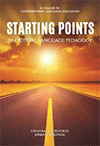
Starting Points in Critical Language Pedagogy
By:
Graham V. Crookes, University of Hawaiʻi at Mānoa
Arman Abednia, Murdoch University, Australia
A volume in the series: Contemporary Language Education. Editor(s): Terry Osborn, University of South Florida.
Published 2022
Critical language pedagogy, also sometimes referred to as critical ELT, where English is the primary language involved, has a literature in which theoretical and specialized work has outstripped more practically-oriented material. Nevertheless, even practically-oriented publications in this area tend to address the experienced, well-resourced teacher, as opposed to those beginning in this area, or those without much professional support. With a view to helping prepare second language teachers to begin to engage with critical language pedagogy, the authors of this book start from areas of conventional L2 curriculum that teachers naturally use. Each chapter presents material pertinent to areas of language, language teaching and course delivery, starting from a fairly conventional perspective. It then attempts to explain how this conception can be extended drawing upon the ideas of critical (language) pedagogy and teachers' experiences.
The authors' experience of working with teachers, who work under different circumstances, in teacher education courses and workshops form key elements of the book. Teachers’ voices are also given adequate space so as to provide a comprehensive picture and situated understanding of critical language pedagogy.
Dialogical engagement with the initial perspectives of beginning critical language pedagogy teachers who do not necessarily have a fully-worked out "critical philosophy of teaching" or those who wish to practice critical ELT is another feature of the book. Finally, to strengthen the practical orientation of the book, teaching strategies and extracts of materials and lesson plans are also provided.
CONTENTS
Preface. Acknowledgment. CHAPTER 1: Introduction. CHAPTER 2: First Steps Toward a Critical ELT Classroom. CHAPTER 3: Content in Critical ELT Classroom. CHAPTER 4: Reading the Word—Reading the World. CHAPTER 5: Critical L2 Writing Pedagogy. CHAPTER 6: Grammar. CHAPTER 7: Critical L2 Speaking and Listening. CHAPTER 8: Handling Pronunciation Critically: Issues and Techniques, Standards and Varieties. CHAPTER 9: Democratic Assessment. CHAPTER 10: Development or Self-Development as Critical L2 Teachers. CHAPTER 11: The Critical Language Teacher Beyond the Classroom. CHAPTER 12: Envoi—Closing Remarks. References. About the Authors.
-
Paperback978-1-64802-491-7
Web price: $45.04 (Reg. 52.99)
-
Hardcover978-1-64802-492-4
Web price: $80.74 (Reg. 94.99)
- eBook978-1-64802-493-1

- EDU018000 - EDUCATION: Language Experience Approach
- EDU029080 - EDUCATION: TEACHING METHODS & MATERIALS: Language Arts
- EDU044000 - EDUCATION: Classroom Management
-
 Democracy and World Language Education
Toward a Transformation
Democracy and World Language Education
Toward a Transformation
-
 How We Take Action
Social Justice in PK-16 Language Classrooms
How We Take Action
Social Justice in PK-16 Language Classrooms
-
 Identifying and Recruiting Language Teachers
A Research-Based Approach
Identifying and Recruiting Language Teachers
A Research-Based Approach
-
 Intercultural Competence in Instructed Language Learning
Bridging Theory and Practice
Intercultural Competence in Instructed Language Learning
Bridging Theory and Practice
-
 Researching edTPA Promises and Problems
Perspectives from English as an Additional Language, English Language Arts, and World Language Teacher Education
Researching edTPA Promises and Problems
Perspectives from English as an Additional Language, English Language Arts, and World Language Teacher Education
-
 The Seal of Biliteracy
Case Studies and Considerations for Policy Implementation
The Seal of Biliteracy
Case Studies and Considerations for Policy Implementation
-
 Understanding the World Language edTPA
Research‐Based Policy and Practice
Understanding the World Language edTPA
Research‐Based Policy and Practice

